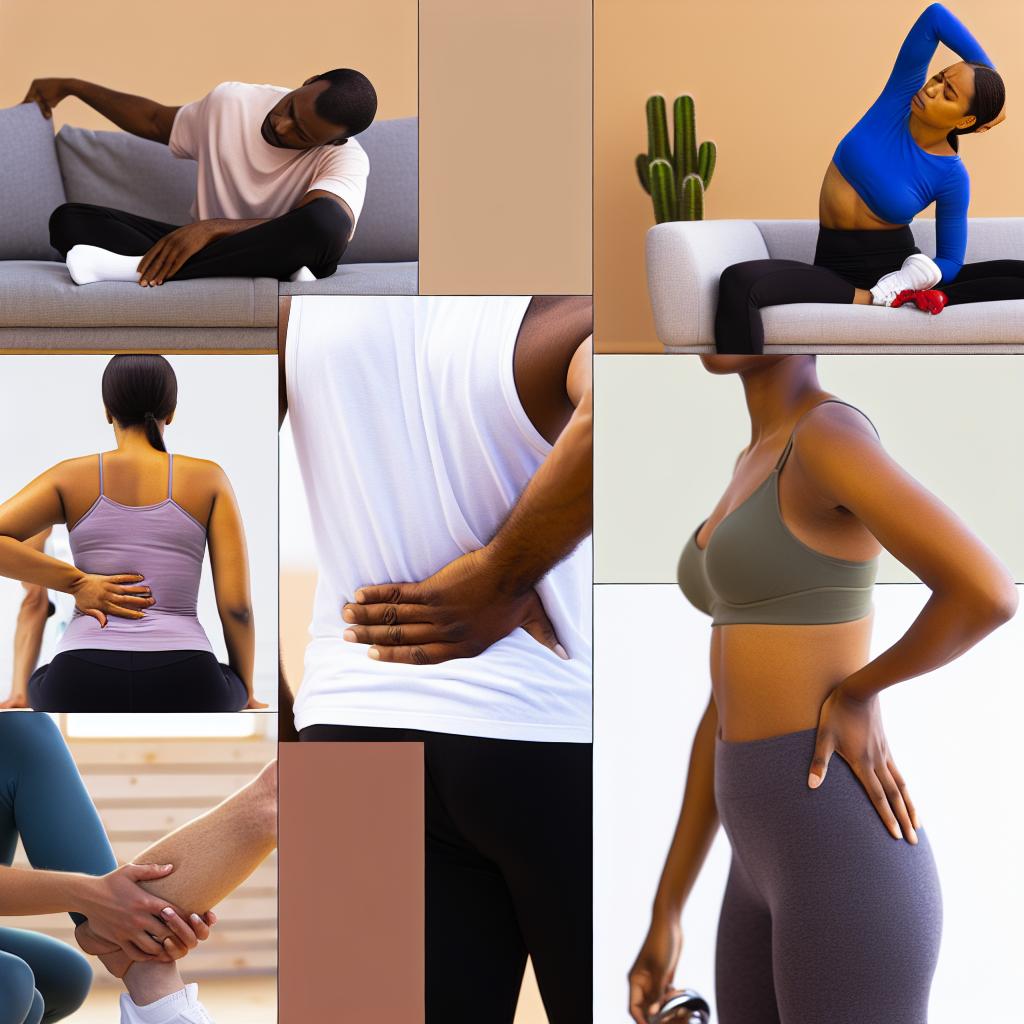Are you finding yourself asking, “Why Does My Back Hurt After Stretching? causes and Fixes”? You’re not alone—many of us have fallen into the trap of thinking that a good stretch is the remedy for all back woes, onyl to discover that it can sometimes make things feel way worse. It’s almost like your back is throwing a little tantrum: “You wanted to stretch? How about a little pain to spice things up!” But fear not, because in this article, we’ll dive into the hilarious yet frustrating world of post-stretch back pain, uncover the sneaky culprits behind it, and arm you with clever fixes that could just turn your stretching routine from a pain in the back to a pain-free joy! So grab your mat and let’s unravel the mysteries of why those stretches sometimes feel like an uninvited guest at a party!
## Understanding Why Does My Back Hurt After Stretching? Causes and Fixes
Common Causes of Back Pain After Stretching
Experiencing back pain after stretching can be concerning, but understanding the potential causes can definitely help address the issue effectively. Some common reasons include:
- Muscle Strain: Overstretching or performing stretches incorrectly can lead to muscle strains, resulting in discomfort.
- Nerve Compression: A pinched nerve in the spine can lead to pain, which may not feel like typical soreness from muscle use [2].
- Underlying conditions: Conditions like herniated discs or sciatica can be aggravated by stretching, causing pain during or after the activity [3].
Fixes and Preventive Measures
To alleviate back pain after stretching, consider the following strategies:
- Proper Technique: Ensure you are using correct stretching techniques. Consult with a physical therapist or watch instructional videos.
- warm Up: Before engaging in deep stretches, warm up your muscles with light aerobic activity to increase blood flow and prepare them for stretching.
- Gentle Stretches: Start with gentle stretches and gradually increase intensity to avoid overstressing the muscles. Here are a few basic stretches:
Gentle Stretch Examples
- Cat-Cow Stretch
- Child’s Pose
- Seated Forward Fold
When to Seek Professional Help
If back pain persists despite following these tips, it may be time to consult a healthcare professional. Persistent pain could indicate a more severe underlying issue that requires targeted treatment.
## Common Causes of Back Pain After Stretching
Muscle Strain
One of the most common causes of back pain after stretching is muscle strain. Overstretching or improperly performing stretches can lead to strains in the back muscles, resulting in discomfort. To avoid this:
- Start with gentle stretches and gradually increase intensity.
- Ensure your warm-up routine is sufficient to prepare your muscles.
Poor Technique
Poor stretching technique can increase the risk of injury. Incorrect form may put excessive strain on the back, leading to pain. Consider the following tips for better techniques:
- Maintain a neutral spine while stretching.
- Avoid forcing your body into positions that cause discomfort.
Underlying Conditions
Sometimes,underlying medical conditions such as herniated discs or arthritis can contribute to back pain after stretching. If you suspect an underlying issue:
- consult with a healthcare professional for a thorough evaluation.
- Engage in stretching that is specifically tailored to your condition,ideally under professional guidance.
Important Stretches for Relief
Incorporating the following stretches can help alleviate back pain:
- Cat-Cow Stretch: Improves flexibility and relieves tension.
- Child’s Pose: Gently stretches the lower back.
- Piriformis Stretch: Addresses tightness in the hip area, which can affect the back.
## How to Identify the Source of Your Back Pain
Recognize the symptoms
Identifying the source of your back pain after stretching involves closely observing your symptoms.Common indicators can include:
- local pain: Pain concentrated in a specific area, often indicating a strain or sprain.
- Radiating pain: Pain that travels down the legs may suggest nerve involvement, such as sciatic nerve irritation.
- Stiffness or tightness: Persistent feelings of stiffness can indicate muscle fatigue or strain.
Assess Your Stretching Technique
A critical step in identifying the cause of back pain is to review your stretching routine. Consider the following:
- Warm-up: Ensure your muscles are adequately warmed up before stretching.
- Form and alignment: Maintain proper alignment to avoid undue stress on your spine. Avoid bouncing or overstretching.
- Duration: Hold stretches for a balanced duration (15-30 seconds) without forcing your body.
Common Stretching Mistakes
Be aware of these common mistakes that can contribute to back pain:
- overstretching beyond your limits.
- Ignoring tightness signals from your body.
- Not modifying stretches to accommodate your flexibility level.
Consult a health Professional
if your back pain persists, it is advisable to consult a healthcare professional. They can definitely help you:
- Identify underlying conditions that might potentially be causing your pain, such as herniated discs or nerve issues.
- Provide personalized recommendations and effective treatment options.
- Guide you in modifying your exercise regimen to prevent future discomfort.
## Practical Solutions for Preventing Back Pain After Stretching
Understanding Your Body Mechanics
To effectively prevent back pain after stretching, it’s crucial to understand your body’s mechanics. Pay attention to how your body responds during stretching sessions, notably in your lower back. Improper posture and overextending can exacerbate back pain. Utilize the following tips:
- Maintain Proper Alignment: Keep your spine neutral and avoid arching your lower back. Engage your core to support your pelvis.
- Focus on Symmetry: Ensure that you are stretching both sides of your body equally to avoid imbalances that could lead to discomfort.
- Modify stretches: If a stretch causes pain in your back, consider modifying the range of motion or substituting it for a less intense option.
incorporating Strengthening Exercises
Strengthening your core muscles plays a vital role in supporting your lower back, which can definitely help reduce pain after stretching. Include these exercises in your routine:
Recommended Core Exercises:
- Planks: Hold a plank position for 20-30 seconds, ensuring a straight line from head to heels.
- Bridges: Lie on your back, bend your knees, and lift your hips, engaging your glutes and lower back.
- Bird-Dogs: From a tabletop position, extend one arm and the opposite leg while keeping your spine neutral.
Post-Stretching Recovery Techniques
Engaging in proper recovery techniques post-stretching can definitely help alleviate back pain:
- Gentle Movement: Consider light walks or movement to enhance blood flow to the back muscles.
- Ice or Heat Therapy: Apply ice or a heating pad to the back for 15-20 minutes to reduce inflammation or relax muscles.
- Foam Rolling: Use a foam roller to gently massage tight muscles in the back and release tension.
## Effective Stretches to Alleviate Back Discomfort
Gentle Stretching Techniques
Incorporating gentle stretches into your routine can considerably alleviate back discomfort. It’s important to perform these stretches slowly and mindfully to avoid further irritation.
- Cat-Cow Stretch: Start on your hands and knees. Inhale as you arch your back (cow), and exhale as you round your spine (cat). Repeat this sequence for 5-10 breaths.
- Child’s Pose: From your knees,lower your torso down to your thighs,stretching your arms forward. Hold for 30 seconds, focusing on breathing deeply to relax your back muscles.
Stretching for lower Back Pain Relief
Employing targeted stretches can definitely help relieve tension in the lower back. Perform these stretches gently, holding each position for at least 20-30 seconds without bouncing.
- Knees to chest: Lie on your back and pull your knees towards your chest. This motion helps elongate the lower back.
- Seated Forward Bend: Sit with your legs extended, and gently reach towards your toes while keeping your back straight. This stretch encourages flexibility in the spine.
When to Consult a Professional
If discomfort persists or worsens after stretching, it may be beneficial to consult with a healthcare professional. They can provide tailored stretches and exercises that address the specific mechanics of your back pain.
## strengthening exercises to Support a Healthy Back
core Strengthening Exercises
Strengthening your core is essential for supporting a healthy back. A strong core stabilizes your spine and improves overall posture. Here are some effective exercises:
- Pelvic Tilts: Lie on your back with your knees bent. Tighten your abdominal muscles and push your lower back into the floor. Hold for a few seconds before releasing. Repeat 10-15 times.
- Partial Abdominal crunches: Start by lying on your back with knees bent. Cross your arms over your chest, lift your shoulder blades off the ground, while keeping your lower back pressed into the floor. Avoid pulling on your neck.Perform 10-15 repetitions.
Lower Back and Glute Strengthening
Incorporating glute exercises can significantly alleviate lower back pain and enhance stability. Consider these movements:
- Bridges: Lie on your back with knees bent and feet flat on the ground. Press through your heels and lift your hips towards the ceiling, squeezing your glutes at the top.Hold for a few seconds and lower back down. Aim for 10-15 repetitions.
- Bird-Dog: Start on all fours, ensuring your back is flat.Extend your right arm forward and your left leg back simultaneously. Hold for a moment, than return to the starting position. Alternate sides for 10-15 repetitions.
stretching for Flexibility and Relief
Balance strengthening with stretching to enhance flexibility and prevent pain:
- cat-Cow Stretch: On all fours, alternate between arching your back (cat) and dipping it (cow). This gentle stretch improves spinal mobility and can help relieve tension.
- Child’s Pose: Kneel and sit back on your heels with your arms extended forward. This position gently stretches the back and provides relaxation.
## Home Remedies for Managing Back Pain After Stretching
Rest and Recovery
After experiencing back pain following stretching, it’s essential to prioritize rest and recovery. Allowing your body to recuperate can definitely help alleviate discomfort. here are effective strategies:
- Short Rest Periods: Take breaks between activities to prevent further strain.
- Gentle Movement: Engage in light activities like walking to keep the muscles from stiffening.
Heat and Cold Therapy
Utilizing heat and cold therapy can significantly relieve back pain:
Cold Therapy
Apply a cold pack for the first 24-48 hours after stretching:
- Wrap ice in a towel or use a cold pack.
- Apply for 15-20 minutes every hour.
Heat Therapy
After the initial swelling has reduced, switch to heat therapy:
- Use a heating pad or warm towel.
- apply for 15-20 minutes to relax tight muscles.
Stretching techniques
Incorporating specific stretching techniques can enhance recovery:
- Cat-Cow Stretch: Alternate between arching and rounding the back. Hold each position for 5-10 seconds.
- Child’s Pose: Kneel and stretch forward,keeping your arms extended. Hold for 15-30 seconds to relieve tension.
Considerations for Footwear
Pay attention to your footwear, as improper shoes can contribute to back pain:
- Choose supportive shoes with cushioning.
- Avoid high heels or flat shoes lacking arch support.
Massage and Choice Therapies
If pain persists, consider massage therapy or other alternative treatments:
- Seek professional massage to alleviate muscle tension.
- Explore acupuncture, which may help reduce pain intensity.
## Challenges and Considerations in Stretching Safely
Understanding the Causes of Back Pain After Stretching
Experiencing lower back pain after stretching can arise from several factors.One common reason is muscle tightness, which may lead to overstretching during certain exercises. To ensure safety, it’s essential to identify your limits and listen to your body before pushing it too far. additionally, underlying conditions, such as disc herniation or poor posture, can exacerbate discomfort during and after stretching sessions [[[[[3]].
Considerations for Stretching Safely
- Always warm up your body before starting your stretching routine.
- focus on maintaining proper form and alignment to avoid undue stress on the back.
- Incorporate a mix of dynamic stretches followed by static stretches to gradually prepare your muscles.
Strategies to Protect Your Back
To minimize the risk of injury and back pain during stretching, consider these actionable strategies:
- Perform stretches within a cozy range of motion, but do not exceed your limits.
- Incorporate core strengthening exercises to support your back and improve stability.
- Stay hydrated and nourish your body to maintain muscle elasticity.
Suggested Stretching Routine
| Stretch | Duration | Notes |
|---|---|---|
| Cat-Cow Stretch | 30 seconds | Focus on smooth, controlled movements. |
| Child’s Pose | 30 seconds | Relax your back and breathe deeply. |
| Knee-to-Chest Stretch | 30 seconds per leg | Feel a gentle pull in your lower back. |
## Key Takeaways on Why Does My Back Hurt After stretching? Causes and Fixes
Common Causes of back Pain After stretching
Experiencing back pain after stretching can be linked to several factors. One meaningful reason is muscle strain, which may occur if the muscles are not properly warmed up before stretching. additionally, poor posture during stretches can place undue stress on the back, leading to discomfort. in some cases, underlying issues such as herniated discs or nerve-related conditions, often stemming from the spine, can be the cause of your pain.
Identifying Key Symptoms
- Sharp or stabbing pain in the lower back
- Radiating pain to the hips or pelvis
- Pain that worsens during specific movements or positions
Effective Fixes and Prevention Strategies
To alleviate and prevent back pain after stretching, consider the following strategies:
- Warm-Up Properly: Always engage in a gentle warm-up before stretching, focusing on the muscle groups you plan to stretch.
- Improve Posture: Maintain good posture throughout your stretching routine. Avoid hunching and ensure your spine is aligned.
- Modify Your Routine: If certain stretches cause pain, adjust them or consider consulting a physical therapist for personalized modifications.
Beginner-friendly Stretching Routine
| Stretch | Instructions | Duration |
|---|---|---|
| Cat-cow Stretch | Start on hands and knees. Alternate arching and rounding your back. | 1 minute |
| Sitting Forward Bend | Sit with legs extended, slowly reach toward your toes, keeping the back straight. | 30 seconds |
| Child’s Pose | Kneel down, sit back on your heels, and stretch your arms forward on the floor. | 1 minute |
## Encouragement to Seek Professional Help if Needed
Recognizing When to Seek Help
Listening to your body is crucial, especially when experiencing persistent pain after stretching. If you notice that discomfort escalates rather than decreases, it may be time to consult a professional. Healthcare providers—such as physical therapists,chiropractors,or orthopedic specialists—can provide tailored assessments and interventions that may not only relieve your pain but also prevent it from recurring.
Signs You Should Seek Professional Help
- Persistent or worsening pain that lasts more than a few days.
- Difficulty performing daily activities due to discomfort.
- Numbness, tingling, or weakness in your legs or arms.
- Back pain accompanied by fever, unexplained weight loss, or bowel/bladder issues.
Benefits of Professional Guidance
Engaging with a skilled professional can offer numerous advantages for your back health, including:
- Accurate Diagnosis: Identifying the root cause of your pain is essential to effective treatment.
- Customized Treatment Plans: Professionals can create individualized programs that align with your specific needs.
- Education: Learn about body mechanics,posture,and safe stretching techniques to minimize future injuries.
Remember, seeking help is a sign of strength and proactivity when it comes to maintaining your health.
Q&A
### Why Does My Lower Back hurt After Stretching?
Many people experience lower back pain after stretching. This discomfort can arise for several reasons, including improper techniques or pre-existing conditions. **Understanding** these causes can help you avoid pain after stretching.
**Common causes include:**
– **Muscle tightness and imbalances**: When certain muscles are tight, they can put strain on the back during stretches.
- **Improper form**: Incorrect posture or technique during stretching can lead to injury.- **overstretching**: Pushing beyond your limits can cause strain.
To alleviate this pain, ensure you’re using proper technique and listen to your body. Gradually increase your flexibility instead of forcing stretches.
### How Can I Stretch safely to Avoid Back Pain?
To prevent back pain during stretching, focus on safe and effective methods. Here are some key steps:
1. **Warm Up**: Always start with a few minutes of gentle movement to increase blood flow to your muscles.This prepares your body for stretching.
2. **Use proper Technique**: Keep your back straight and shoulders relaxed while stretching. Avoid leaning too far or bouncing.
3. **Listen to Your Body**: If you feel any pain, stop the stretch immediately. Stretching should feel comfortable and relieving, not painful.
4. **Incorporate Back-Specific Stretches**: Focus on stretches designed to ease lower back tension, such as the cat-cow stretch or child’s pose.
By following these guidelines, you can engage in a stretching routine that enhances flexibility without causing discomfort.
### What Are Some Recommended Stretches for Lower Back Pain?
Certain stretches specifically target the lower back and can relieve pain.Here are a few you might find beneficial:
– **Cat-Cow Stretch**: This stretch promotes flexibility in the spine and relieves tension in the lower back.
– **Child’s Pose**: A gentle stretch that helps elongate the spine and relax the back muscles.
– **Knees to Chest Stretch**: Pulling your knees to your chest while lying on your back can reduce tension in the lumbar area.
Perform these stretches slowly and hold each for 15-30 seconds. Gradually integrate them into your routine for optimal results.
### Could My Back Pain Be a Sign of a More Serious Issue?
While occasional back pain after stretching can be normal, persistent or severe pain might indicate a more serious condition.It’s essential to pay attention to your symptoms.
**Watch for signs including:**
– Severe pain that doesn’t improve with rest
– Pain radiating down your legs
- Numbness or tingling in the lower body
If you experience these symptoms, consult a healthcare professional for advice.They can provide a proper diagnosis and recommend treatments.
### How Does Hydration Affect My Muscle Flexibility and Back Pain?
Staying hydrated is crucial for muscle function and flexibility. Dehydrated muscles can lead to stiffness, making stretching less effective and potentially painful.
**Tips for maintaining hydration:**
– Drink water throughout the day, particularly before and after stretching.
– Consider incorporating hydrating foods, such as fruits and vegetables, into your diet.
Being well-hydrated not only supports muscle elasticity but also regulates muscle contractions, reducing the likelihood of strain.
### Should I Stretch if I Have Existing Back Problems?
If you have existing back issues, stretching can be beneficial, but it requires caution. Always discuss with your healthcare provider before starting a new stretching regimen,especially if you have a history of back problems.
**Consider the following:**
– **Modify your stretches**: Tailor your routine to avoid positions that exacerbate your pain.
– **Focus on gentle stretches**: Emphasize flexibility routines that are low-impact and gradual.
– **involve professional guidance**: Physical therapists can create a personalized stretching plan that aligns with your specific needs.
being proactive about your stretching practice can help manage existing conditions while promoting overall flexibility.
In Retrospect
### Conclusion: Taking Steps to Relieve Back Pain After Stretching
Understanding why your back may hurt after stretching is the first step towards effective relief and injury prevention. Here’s a recap of key points and actionable steps to help you address and mitigate discomfort:
#### Key Causes of Back Pain After Stretching
– **Nerve-related Issues**: Discomfort may stem from nerve involvement in the spine, rather than muscle fatigue or soreness [[1](https://integrativephysicalhealth.com/why-your-back-hurts-after-stretching/)].
– **Overstretching**: Trying to stretch too aggressively can exacerbate stiffness and lead to more pain[[[[[2](https://backinshapeprogram.com/2023/11/why-your-lower-back-is-stiff-stop-trying-to-stretch-it-more/)].
#### Actionable Steps to Alleviate Pain
1. **Evaluate your Stretching Routine**
– Focus on gentler stretching techniques.
– Avoid deep or forceful stretches, especially if they lead to pain.
2. **Incorporate Strengthening Exercises**
– Balance your stretching routine with strengthening exercises for your core and back muscles to provide better support and stability.3. **Listen to Your body**
- Pay attention to pain signals. If something feels wrong during a stretch, stop immediately.
4. **Consult a Professional**
– If pain persists, consider seeing a physical therapist or healthcare provider for personalized advice and treatment options.
5. **Practice regular Maintenance**
– Engage in a consistent routine of gentle stretching and strengthening to promote flexibility and reduce the likelihood of injury.
#### Final Thoughts
Remember, it’s important to treat your back with care. By making small adjustments to your routine and understanding the reasons behind your discomfort, you can move towards a pain-free experience with stretching. Don’t hesitate to reach out for help if needed—your well-being is worth it!












